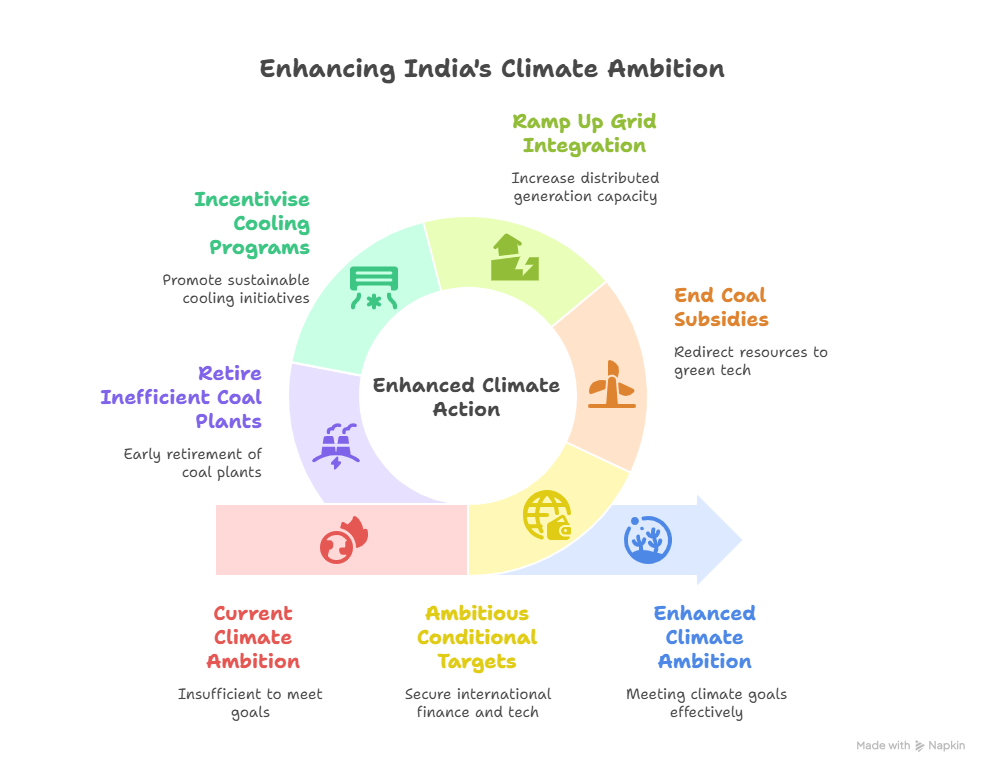Font size:
Print
India’s Climate Goals: Strong Progress but Big Hurdles Remain
Is India on Track to Meet Its Climate Goals?
Context: India has achieved a key climate goals under the 2015 Paris Agreement five years ahead of schedule, with non-fossil fuel sources now accounting for over 50% of its installed electricity generation capacity.
What are India’s key climate targets under the Paris Agreement?
- Non-fossil fuel-based capacity: Achieve 50% of total installed electricity generation capacity from non-fossil fuel sources.
- Emissions intensity: Reduce the emissions intensity of its GDP by 45% from 2005 levels.
- Carbon sink enhancement: Create an additional 2.5 to 3 billion tonnes of carbon dioxide (CO₂) equivalent through enhanced forest and tree cover.
Why is India still expanding coal despite growth in renewables?
- India’s peak electricity demand is rising sharply due to Extreme summer heatwaves, Rapid urbanisation and economic growth & Growing cooling and industrial demand.
- In response: Coal production and imports hit record highs in H1 2024, Coal-fired plants were directed to operate at full capacity & Imported coal blending was increased to avoid blackouts.
- Grid storage infrastructure, currently just 4 GW, is insufficient. India needs 74 GW of storage by 2031–32, as per the National Electricity Plan (2023), to handle non-solar peak demand.
These targets were formally submitted to the UNFCCC and later revised upward in India’s updated NDC (August 2022), reflecting enhanced ambition.
When and how did India achieve the non-fossil fuel capacity target?
- India achieved the 50% non-fossil fuel installed capacity target in June 2025, five years ahead of schedule. According to the Ministry of Power and the Central Electricity Authority (CEA):
- Total installed capacity (June 2025): 484.82 GW
- Non-fossil share: 242.78 GW (~50.1%): Includes solar, wind, large hydro, and nuclear.
- The achievement is primarily due to rapid deployment of solar energy, which added nearly 24 GW in 2024 alone, the highest ever in a single year.
Where does India stand on the emissions intensity target?
As per the latest data submitted to the UNFCCC:
- By 2020, India had already achieved a 36% reduction in emissions intensity from 2005 levels.
- Though updated post-2020 data is lacking, India is on track to meet or exceed the 45% reduction target by 2030.
- Emissions intensity is calculated as total greenhouse gas emissions per unit of GDP. This allows countries like India to grow economically while still reducing emissions relative to output.
Who monitors India’s forest carbon stock, and has India met the carbon sink goal?
- India’s carbon sink data is monitored by the Forest Survey of India (FSI) and reported in the biennial India State of Forest Report (ISFR).
-
Key data points:
-
- Additional sink created by 2021: 2.29 billion tonnes CO₂ equivalent
- Annual increase (2017–2021): ~150 million tonnes/year
- Projected total by 2023 (pending ISFR 2023 data): Likely exceeds 2.5 billion tonnes, thus meeting the lower end of the target.
- The forestry goal is likely already achieved, ahead of 2030, pending official confirmation.

What are the challenges in aligning India’s pathway with the 1.5°C Paris target?
According to Climate Action Tracker (CAT) and other independent analyses:
- India’s current fossil fuel usage is not aligned with the 1.5°C goal.
- To align:Coal generation must drop to 17–19% of electricity mix by 2030.
- Storage, green hydrogen, and grid modernisation must be accelerated.
- A plan for early retirement of coal capacity is needed.
How has policy continuity helped? What are some recent government initiatives?
- With Prime Minister Modi’s third term beginning in June 2024, policy continuity is expected. Recent measures include:
- Policy incentives for domestic solar and wind manufacturing
- Rooftop solar and PM-Surya Ghar Yojana for residential clean energy
- Support for green hydrogen development under the National Hydrogen Mission
- Emphasis on renewables + storage solutions in procurement bids
- Investments in renewables grew by 83% in 2023–24, signalling investor confidence.
Subscribe to our Youtube Channel for more Valuable Content – TheStudyias
Download the App to Subscribe to our Courses – Thestudyias
The Source’s Authority and Ownership of the Article is Claimed By THE STUDY IAS BY MANIKANT SINGH


